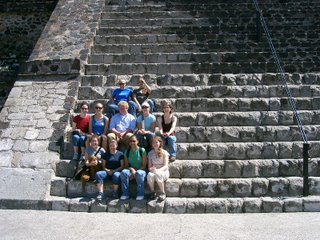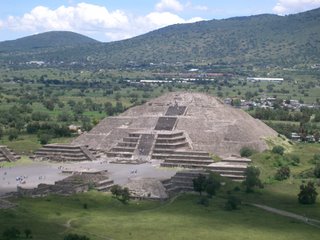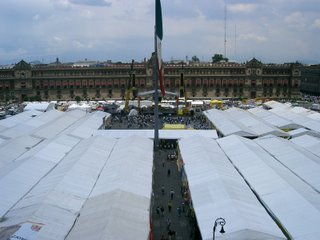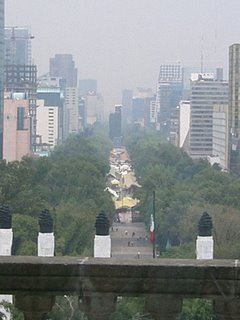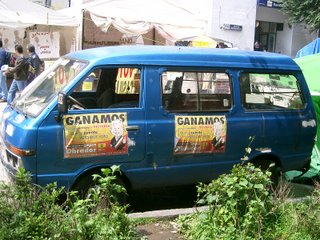The weekend before last, we visited Tonantzintla and Cholula. Cholula is close to being swallowed by Puebla and you wouldn't know Tonantzintla is separate from Cholula if no one told you. In Tonantzintla we saw a couple beautiful churches with Talavera tiles on the front. This is a very common way of decorating churches in and near Puebla. Instead of covering the front of the church with stone carvings of Biblical characters or stories and other decorations, the fronts are decorated with these colorful tiles. Often there are a few tiles with the characters or stories painted on them and the rest is decoration (though not in Tonantzintla). All the colors make quite a contrast to the dark grays of the stone churches in Europe or to the white churches in the US.
Bright colors here are the norm, not just in churches. Store buildings are painted all sorts of bright reds, yellows, oranges, purples, pinks, all different colors. Instead of using a separate sign for the stores, the owners paint the store names and advertisements directly onto the buildings. Some are quite elaborate and again, colorful. It seems like a good idea to me to paint directly on the building. Why spend the money on a sign when you have a clean palate right there waiting to be used?
Back to the excursion: The insides of the churches in Tonantzintla were also interesting. The town has a huge indigenous population. The indigenous people were the ones to build the churches. For this reason, many of the people depicted in the churches have faces that appear more native than Spanish. The angeles in the churches of Tonantzintla are famous for this reason.
In Cholula, we visited the archeological site. Cholula claims itself to be the longest continually inhabited town in the Americas, but I think this has to be a hard thing to prove. Anyway, people have lived there for a LONG time, that's the point. The town grew to one of Mexico's largest cities and powerful religious centers between 1-600 AD, at the same time as Teotihuacán was powerful. Cholula fell to the Olmeca-Xicallanca around 600 AD and later to the Toltecs/Chimichecs around 1300 AD and later it fell under the Aztec's rule.
In Cholula stands the widest pyramid ever built (this I do believe). The Cholulans built over the pyramid numerous times so entering into the archeological tunnels into the pyramid, we were able to see parts of the older pyramids, such as the stairs that scaled the sides. Now, the entire pyramid is overgrown and covered in dirt and grass. In fact, the Spaniards didn't know it was a pyramid when they arrived. They thought it was simply a large hill near the town of about 100,000 people. Today, there is a church on the top of the pyramid. The legend goes that some colonial clergyman noticed that the indigenous people of Cholula frequently visited the top of this hill. He went to investigate and found a small altar with offerings at the top. He decided that the devil was present there and so he planted a cross in place of the altar. The story goes that a bolt of lightening struck down the cross. The priest put a second cross up which was also struck down. Finally with the third cross, "God prevailed" and the cross survived. This is said to be the first exorcism in Nueva España.
The day we climbed to the top of a pyramid, there was a wedding going on inside. All I have to say is that that bride must be crazy because the only way to get to the top of the pyramid is to walk, and it was a hot day. It must have been horrible to walk up the whole way in her beautiful, heavy wedding dress with a long trail!
This past weekend, we visited Cacaxtla, Xochitécatl and Tlaxcala, all fairly close to Puebla. Cacaxtla and Xochitécatl are in the middle of fields of agriculture and are archeological sites. Cacaxtla was the capital of the Olmeca-Xicallanca group (the group that took over Cholula around 600AD. After Cholula fell, the Olmecas became the chief power in the southern Tlaxcala and Puebla valley. Its peak was between 600-900AD. At Cacaxtla we saw several pyramids, they largest of which was the most interesting. The pre-Hispanic people build buildings to be used from the outside. High priests lived on top of the pyramids, not inside them, for example. They used different levels to create privacy. The Cacaxtla pyramid was once covered with dirt and vegetation, but archeologists have uncovered the top. We learned how archeologists decipher the uses for different rooms: in rooms that were frequently used, usually bedrooms, they find concentrations of carbon dioxide and other compounds that humans release, high concentrations of proteins indicate an area used for washing and carbon deposits show where cooking was done. We could actually see the burnt areas from fires that had been preserved over a thousand years! This pyramid was also built over several times, so we saw various levels of construction.
The Cacaxtla pyramid is most famous for its murals with the vivid reds and more importantly blues. Cacaxtla is far from the Mayan region in the Yucatan Peninsula and yet the murals at Cacaxtla use a blue can only be found in the Mayan region (I forget what our archeologist guide said it is made from). Also, the people in the murals have head deformations like Mayans (the Mayans, even today, place two pieces of wood on the front and back of a baby's head to give them a longer forehead and a sort of pointed head). However, though these Mayan influences are seen in Cacaxtla, there is no evidence that the people were actually Mayans or that there had been an invasion or something. The other clues are missing. Archeologists still don't know why this Mayan influence is found in the murals. They really were beautiful murals! It amazes me how well something like that can last through so many years!
After Cacaxtla, we went to Xochitécatl, which is right nearby. There wasn't as much to see there, but it what there was was interesting. Xochitécatl is known for its representations of woman. Many small statues and pendants of women have been found. Some even show women during pregnancy and have a little door in the front that can be opened to reveal the baby inside. It is also the location of a round pyramid, a structure much less common than the square pyramids.
Finally, we visited Tlaxcala, the capital of the state of Tlaxcala. This was the city in which Cortés gained his first allies. The Tlaxcalans were under the Aztec rule and wanted to overthrow them. When Cortés arrived, they first battled fiercely and then decided to join him. After the Spaniards defeated the Aztecs, the Tlaxcalans were given special treatment. They didn't have to pay tribute to the Spanish crown like the rest of the indigenous people and their tributes to the church were less. The first bishop in Nueva España had his seat in Tlaxcala. The seat was later moved to Puebla when the Spaniards built it as a town for Spaniards. There really wasn't much to see in Tlaxcala other than the cathedral, which wasn't one of the more impressive, but is the oldest in Mexico. One interesting thing we've learned about the churches in general is that at first the indigenous people were scared to enter them. As I said before, they were used to living on outside large structures. The idea of entering into a huge, dark, structure must have been terrifying. For this reason there are many outdoor chapels where priests gave the sermons to the indigenous people until they became used to the churches. There are also quite a few smaller churches built specifically for the indigenous people. The people were smaller than the Spaniards so they required less space and were probably more comfortable in a smaller space than in a gapping Spanish church.
I think that about sums up the excursions we've had. Oh, except one thing. I wrote in my introduction to my trip to Mexico that Puebla is surrounded by high peaks/volcanoes. On our trip to Cacaxtla, we had some amazing views of Popocatépetl, the second highest mountain in Mexico and active, constantly smoking, volcano, and Iztaccíhuatl, also known as the sleeping woman, the third highest mountain and dormant volcano. These two volcanoes share a legend. It goes like this:
Iztaccíhuatl was a beautiful princess. Popocatépetl was a powerful warrior and Iztaccíhuatl's love. The tribe of Izta and Popo went to war and Popo had to fight. His side lost and he was taken captive. Rather than tell his daughter of her lover's failure, Itzaccíhuatl's father told her Popocatépetl had died in battle. Izta's heart was broken and she fell into a deep depression and died. Shortly after, Popo returned, looking for his love. When he found her dead, he carried her to the top of a mountain and laid her there. He stayed and watched over her until he was covered in snow and he too died. Now the two of them are forever there in the mountains. The mountain Iztaccíhuatl looks like a woman lying on her back asleep. Popocatépetl used to look like a man kneeling with one hand to his forehead until the volcano erupted and blew off the top. The story however, remains unchanged.
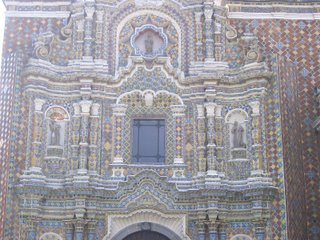
1. Colorful Talavera tiles on front of church in Tonanzintla.
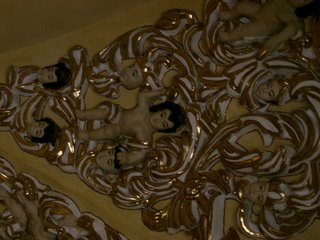
2. Angels of Tonanzintla with indigenous features inside church.
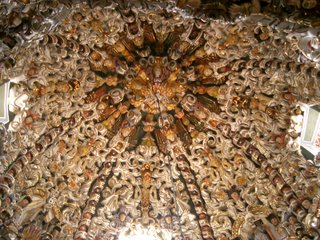
3. Ceiling in church built for and by indigenous people in Tonanzintla.
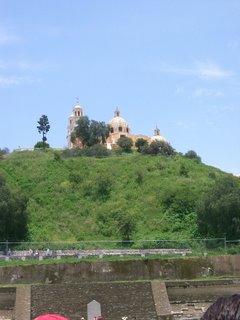
4. Church on top of overgrown pyramid in Cholula.

5. Inside archeological tunnels in Cholula's pyramid. Stairs of earlier pyramid over which the later pyramid was built.
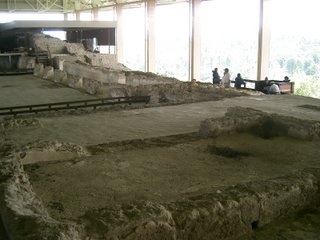
6. On top of the pyramid in Cacaxtla, looking at the living spaces of high priests. Notice the stain from fire. This was probably the kitchen of a house.
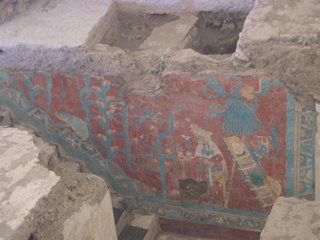
7. On of the murals in Cacaxtla. The blue is the Mayan blue I talked about. This mural is of a tradesman, the person sitting down. His wares on on the board behind him and include shells and feathers of Quetzcalcoatl (also from the Mayan region). The stalks of corn are a part of the creation story. The people of Cacaxtla believed that the gods made humans out of maize. On the left, there is a lizard, which has been identified as a lizard which, when touched, has hallucinogenic effects. Using hallucinogens or other mind altering drugs to connect with the gods or gain knowledge of the supernatural was a common practice for high priests in pre-Hispanic times.

8. Market in Tlaxcala.

9. The smoking Popocatépatl and the valley below.
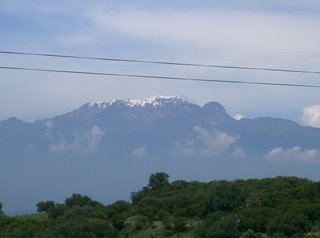
10. Iztaccíhuatl, the sleeping woman. See her head on the right, her bust where the snow is, and her feet sticking up on the left.
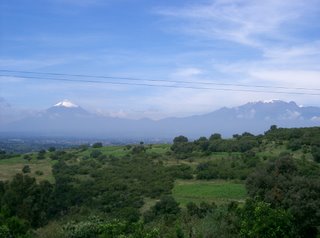
11. Popoctépatl and Iztaccíhuatl.





